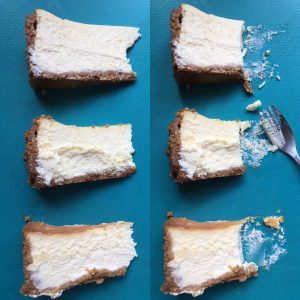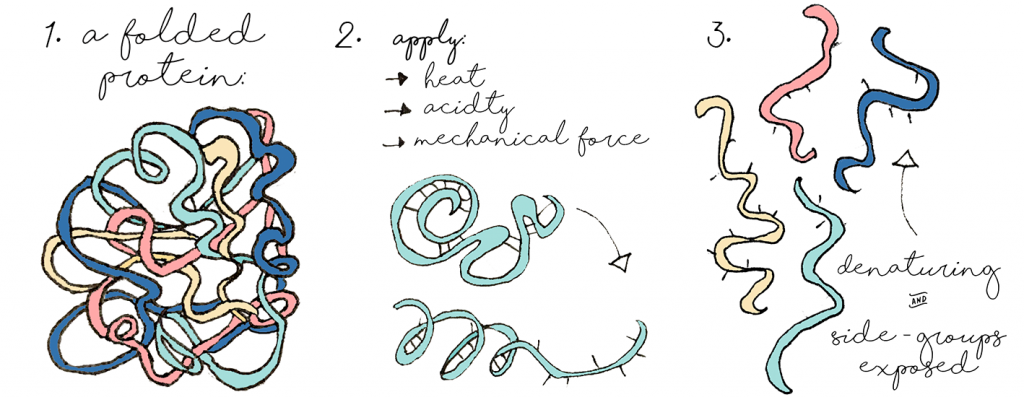A question for the ages…
Making a cheesecake is a bit of an investment. After all, cream cheese isn’t cheap, and you need a lot of it! The worst part is, the outcome feels so uncertain. Will my cheesecake turn out smooth and creamy, practically perfect in every way? Or will it end up with a big ugly chasm right down the middle??
I set out to investigate this awhile ago (pre-kid, when I had a more time), and to develop a crack-proof cheesecake recipe..that was also super delicious of course. It turns out, it all comes down to proteins and how they behave. During my studies, we learned about this, but to see it play out in a more hands-on scenario like a cheesecake recipe, was really fascinating!
Experimenting

First, I had to start baking and see what happened. A big part of cheesecake is texture. I know this can be quite personal. Cheesecakes can range from very solid and creamy, to lighter, crumbly, and almost dry. To me, the ultimate cheesecake is creamy, velvety, and just the tiniest bit crumbly.
So, I basically found every cheesecake recipe I could get my hands on to compare them and see what I could learn. I found a few different uses of ingredients popping up. Through trying these different recipes, I found that the use of each or a couple of these ingredients to reach a desired texture in the end result:
- Flour or other thickeners –> more crumbly to dry texture
- Heavy cream –> dense and creamy
- Sour cream –> smooth, creamy, less dense; more velvety
- Eggs or egg yolks –> depending on the use or egg or yolk, could range from very egg-y to very rich and creamy.
I eventually developed a combination that to me, produced that perfect texture. Now I had a recipe, now the baking method:
During my research, I also found several different techniques to prevent cracking and possible causes. This is where I got lucky. I got a really great tip from a friend (thanks, Annemarie!) which lead me to apply a few other principles to my baking method. I ended up building my whole recipe around these principles. (You can find my cheesecake recipe HERE!) After this, my cheesecake cracking days were over! haha, no really. It turns out, it all comes down to proteins and how they behave under certain conditions. This involves two processes called, ‘Denaturation’ and ‘Coagulation.’
Proteins: Denaturing and coagulating
Unraveling
A protein starts out at a big tangle of individual, but connected curlicues, also known as a ‘folded protein’. When either heat, acidity, or mechanical force is applied to this tangle, it will start to unwind. I’ll use heat for this story as that’s the main cause for cracking. The spiraled curls will slowly untwist, and then disconnect from the other spirals in the protein and straighten out. This process is called ‘denaturation.’
 Network-forming
Network-forming
These spirals, now unwound, are now exposing there ‘side-groups’. These are links that used to hold the spiral together. They’re basically like little arms sticking out on each side.
So now we’ve got a bunch of little straight, unwound curls or ‘strands’ next to each other with little arms sticking out. As more heat is applied, these protein strands will start crossing over each other, and the individual side groups start linking up (a process called ‘cross-linking). A mesh-like pattern of interconnected protein strands is formed called a ‘network’. This whole network-forming process is called ‘coagulation,’ and it basically describes what the inside of your cheesecake is made of- a interlinked structure of protein chains.

The more heat is applied, the tighter your network will become. Think of a hard boiled egg vs a soft boiled one. What makes it hard? All those little tightly connected protein chains. With less heat, the chains have more space in between- a looser and softer texture. Not only the amount of heat, but also the level of heat will affect the texture. A sudden burst of heat will cause a fast network to form, but create a taut and rubbery texture in an egg. Slow and gradual heat creates and softer and creamier texture -a looser and more flexible (aka bendy) network. What’s also interesting, is that this network continues to tighten over time (involving a process called ‘syneresis’), even after the cooking is done, which is explains why a cold, fried egg is so so rubbery.
…And in a cheesecake?
With a cheesecake, this is also happening, and in the end, it’s what can cause a big crack in the center. As the cheesecake is baking, these protein networks are forming. Different temperatures can affect the tightness of the protein network, and ultimately, your cheesecake’s ability to handle the baking process and stay in tact.

Here are the main causes:
1. Uneven baking.
It’s normal that a cheesecake will be slightly more baked around the edges than in the center. However, if this different is too much, the edges will start to pull more as the network tightens. That pulling can cause a crack.
Note: This is why many recommend baking cheesecakes in a water bath- the water will evaporate in the oven before it starts to boil, so it will never get too hot and will stay at a constant temperature. I personally don’t use a water bath in my recipe (I’m really happy with the results without one, and it’s a bunch of hassle), but it does make sense.
2. Over baking
As mentioned before, the center of a cheesecake will always be less done than the edges. This is actually really important. As the cheesecake starts to cool, the edges begin to pull outwards, pulling the center outwards in all directions. The center needs to be bendy enough of withstand this movement. If the middle of your cheesecake is over baked, the network inside will be too tight to withstand this, and break.
3. Extreme temperature changes
This is the big one.
The overall goal in baking a cheesecake is to create a pretty flexible protein network overall. As it’s baking and cooling, the network is forming and solidifying. as gradual and gentle as you can make this process, the better and more delicious your cheesecake will be in the end!
For example, say your cheesecake is exposed to extreme high temperatures at the start of baking, and lower temps later in the baking process. This could cause the cheesecake’s surface to become very inflexible, with the insides still gooey. As the cheesecake rises, the surface won’t be able to withstand the pressure and will crack.
This same goes for cooling.
Say your cheesecake is baked and you take it out right away, or even after 30 minutes or so and put it in the fridge. The insides are still very hot or warm- the coagulation process is still taking place. Exposure to colder temperatures or drafts will once again, affect the evenness of the network being formed. The outside will cool faster than the inside, for instance, solidifying the outer network before the inner network is ready. This is very bad for cheesecakes, and is the main reason why cheesecakes crack as their cooling in the fridge. So, don’t take them out of the oven too soon!
Lastly, if your cheesecake is baked at a too high temp the whole time, it’ll be over baked (see above) but it will also most likely, rise too much, causing little cracks all over the surface.
4. Not greasing the edges (side-splitting)
This is kind of a silly one, and not super related to proteins. Basically the cheesecake will pull away from the sides as it rises. If the edges are still stuck to the inside of your pan, this’ll can cause splitting around the edges. This isn’t a huge deal, but I thought I’d mention it. Once the cheesecake sinks back down, this cracks also sort of close up again.
5. Over mixing
Over mixing can unleash a chain of bad cheesecake-baking events! It can bring too much air in your cheesecake batter. Air will expand in the oven, and could cause your cheesecake to rise too much. Over-rising will mostly like cause the surface of your cheesecake to over bake. See over-baking problems above! 🙂
So, what’s the key to a crack-proof cheesecake (that’s also really delicious)?
Very slow baking + Very slow cooling + Not over-mixing
Since all of these findings, I’ve made a few more tiny adjustments to my old recipe from two years ago. Honestly, I think it’s preeeetty delicious!!
So, to try this out for yourself and see those little proteins in action, you can find my recipe for the Ultimate New York-Style Cheesecake HERE!
